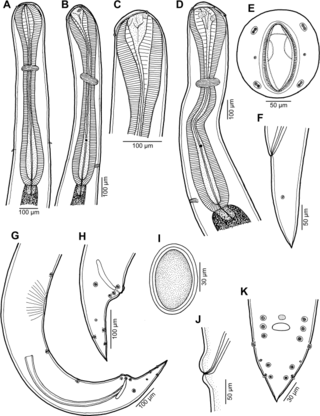
Philometra is a genus of nematodes, which are parasites of marine and freshwater fishes. The genus was erected by Oronzio Gabriele Costa in 1845.

Philometra fasciati is a species of parasitic nematode of fishes, first found off New Caledonia in the South Pacific, in the gonads Epinephelus fasciatus. This species is characterized mainly by: length of spicules and length and structure of its gubernaculum; structure of male caudal end; body size; location in host and types of hosts.

Cucullanus is a genus of parasitic nematodes. The genus includes more than 100 species.

Physalopteridae is a family of spirurian nematodes, which belongs to the superfamily Physalopteroidea. Like all nematodes, they have neither a circulatory nor a respiratory system.

František Moravec is a Czech parasitologist who specialises on the Nematodes, especially the nematodes parasites of fishes. His research is mainly in the field of taxonomy of the Nematoda.

Cucullanus austropacificus is a species of parasitic nematodes. It is an endoparasite of the fish Conger cinereus. The species has been described in 2018 by František Moravec & Jean-Lou Justine from material collected off New Caledonia in the South Pacific Ocean.

Cucullanus incognitus is a species of parasitic nematodes. It is an endoparasite of the rare sparid fish Dentex fourmanoiri. The species has been described in 2018 by František Moravec & Jean-Lou Justine from material collected off New Caledonia in the South Pacific Ocean. Only female specimens were found.

Cystidicolidae is a family of spirurian nematodes. It was described by Skrjabin in 1946. All members of the family are parasites of fish.

Ascarophis is a genus of parasitic nematodes, belonging to the family Cystidicolidae. Species of Ascarophis are parasitic as adults in the gastrointestinal tract of marine and estuarine fishes.
Metabronemoides is a genus of parasitic nematodes, belonging to the family Cystidicolidae. Species of Metabronemoides are parasitic as adults in the gastrointestinal tract of fish.

Moravecnema is a genus of parasitic nematodes, belonging to the family Cystidicolidae. Species of Moravecnema are parasitic as adults in the gastrointestinal tract of fish. According to the World Register of Marine Species, the genus currently (2019) includes a single species, Moravecnema segonzaci, which is a parasite in a deep-sea fish.
Terranova is a genus of parasitic nematodes. Species from this genus are known to parasitise sharks, rays, sawfishes, teleosts and crocodilians.

Euterranova is a genus of parasitic nematodes that have life cycles involving elasmobranchs. The genus was created in 2020 to accommodate species which were previously included inTerranovaLeiper & Atkinson, 1914 a taxon considered to be invalid.

Neoterranova is a genus of parasitic nematodes that have life cycles involving sharks and reptiles. The genus was created in 2020 to accommodate species which were previously included inTerranovaLeiper & Atkinson, 1914 a taxon considered to be invalid.

Cucullanus variolae is a species of parasitic nematodes. It is an endoparasite of the fish species Variola louti (type-host) and Variola albimarginata. The species has been described in 2020 by František Moravec & Jean-Lou Justine from material collected off New Caledonia in the South Pacific Ocean.

Cucullanus acutospiculatus is a species of parasitic nematodes. It is an endoparasite of a fish, the redbelly yellowtail fusilier, Caesio cuning. The species has been described in 2020 by František Moravec & Jean-Lou Justine from material collected off New Caledonia in the South Pacific Ocean.

Cucullanus diagrammae is a species of parasitic nematodes. It is an endoparasite of a fish, the Painted sweetlips Diagramma pictum. The species has been described in 2020 by František Moravec & Jean-Lou Justine from material collected off New Caledonia in the South Pacific Ocean.

Cucullanus parapercidis is a species of parasitic nematodes. It is an endoparasite of fish, the Yellowbar sandperch Parapercis xanthozona, which is the type-host, and the Speckled sandperch Parapercis hexophtalma. The species has been described in 2020 by František Moravec & Jean-Lou Justine from material collected off New Caledonia in the South Pacific Ocean.

Cucullanus petterae is a species of parasitic nematodes. It is an endoparasite of fish, the Honeycomb grouper Epinephelus merra, which is the type-host, and the Blacktip grouper Epinephelus fasciatus. The species has been described in 2020 by František Moravec & Jean-Lou Justine from material collected off New Caledonia in the South Pacific Ocean.

Ichthyofilaroides is a genus of parasitic nematodes, belonging to the family Guyanemidae Petter, 1974.

















